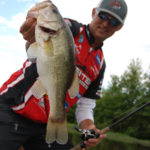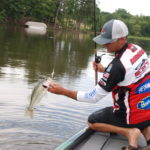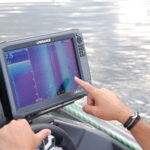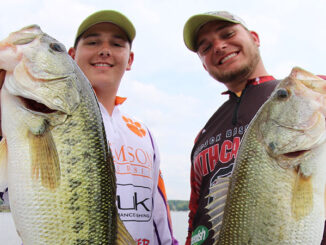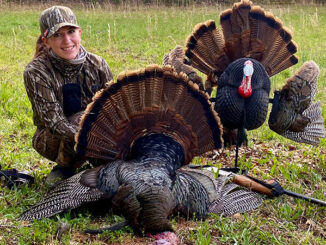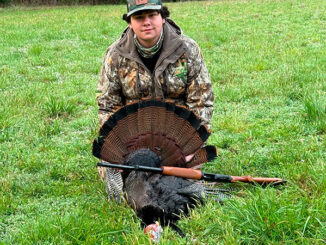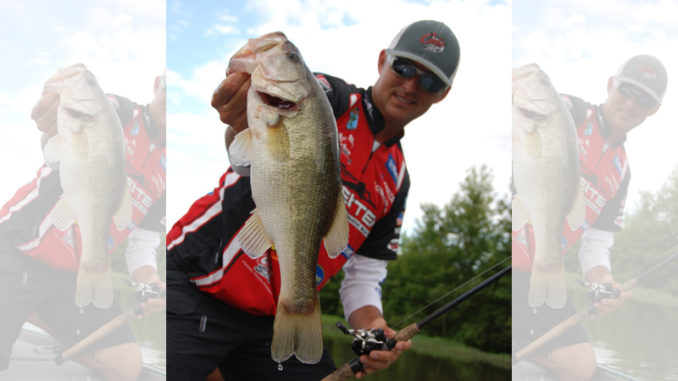
The phrase “They gotta eat sometime” never rings truer for fishermen than in August’s heat. Follow the advice of these expert anglers and learn how to set up a buffet for bass.
Bass pro Marty Robinson has to do more than his share of fishing in less than ideal conditions. He said August may not be a favorite time for bass fishermen to hit the lake, that doesn’t mean you can’t still catch fish.
Across the Carolinas, August typically means the hottest, driest, and least bass-like conditions. But Robinson, a professional bass angler from Lyman, S.C., is quick to point out that even extreme conditions can play in favor of an angler who understands how bass react.
He has three productive summer scenarios he looks forward to. These are clear water, stained water caused by storms, and isolated cover.
On many lakes across North Carolina and South Carolina, water is in short supply during August, except during a tropical storm intervention. Drought conditions make for low and clear water. And Robinson said clear water is always ripe for a good topwater bite.
“The bite could just be in the morning — or it could last all day,” Robinson said. “Bass will become more nomadic and follow baitfish, especially spotted bass. And you can expect a lot of schooling activity as fish suspend below the surface and wait for baitfish to come by.”
Use clear lures in the calmest water
Robinson said a clear-water schooling bite is not very reliable. That’s because fish tend to move with baitfish rather than hold in known locations. He will tailor his topwater baits to the amount of wind that is affecting the surface.
“On calm days, I’m gonna use a clear Spook or a clear topwater walking bait,” he said. “Something they can’t see too well but can hear and will come look for. The windier it gets, the whiter I want my bait to be, and I’ll switch over to shad-imitating patterns with a white bottom.”
Although rain is often hard to come by, afternoon thunderstorms may create surges of water coming into a lake. And after one of those events, Robinson will head all the way back in feeder creeks to try to fool bass that are following baitfish to the run-off.
“They like the cooler water — which brings more oxygen — and so do baitfish. But I don’t get too uptight if I don’t mark baitfish in a feeder creek, because there will always be bluegills to feed on,” he said.
Targeting depths of 8 to 12 feet, Robinson may use a topwater bait early. But his two reliable baits are a Texas-rigged Zoom Ol’ Monster or a half-ounce Buckeye mop jig paired with a Zoom Super Chunk trailer. Both of these are big baits. The worm is 10 ½ inches long, and the jig and trailer are also a mouthful.
Robinson targets any cover in the run-off area. Isolated stumps, brush piles or even a lone boat dock will draw bass to the inflowing water with nearby places to hide.
Never pass up isolated cover when bass fishing
Since runoff is more likely to be stained, his go-to worm color is redbug. He likes a brown jig with a green pumpkin trailer.
The last scenario, isolated cover, is probably the most dependable. To Robinson, isolation means anything that sticks out as an oasis in an otherwise generic waterscape. He’s also going to look for deeper water areas. But that doesn’t always mean he’s going to fish deep.
“When I’m talking about an isolated piece of cover, that might be a lone brush pile where bass suspend in the top of it. Or it might be an old roadbed or rock pile. It might even be a lone dock or set of boat docks in the bend of a creek channel,” he said.
He looks for these features about halfway back in major tributary creeks with some depth. That makes bass feel comfortable during the middle of the day, and gives them a place to which they can fall back.
“I love to throw a medium-running crankbait in the top of a brush pile that’s off by itself,” said Robinson. “My favorite is a Luck “E” Strike ½-ounce crankbait. And the best color is Marty’s Party.”
He may fish shallow areas using a weightless worm or an unweighted Fluke. But he drops back to the jig or worm if he’s working deeper water.
“In this situation, I’m going to rely on my electronics a lot more than I would in the back of the creek or chasing schooling bass on the surface out in the lake,” Robinson said. “If I see something I like hanging on the edge of a channel, then it’s time to go deep and work on them.”
Click here to read about using a combination of lures and live bait to fool wary gamefish.

